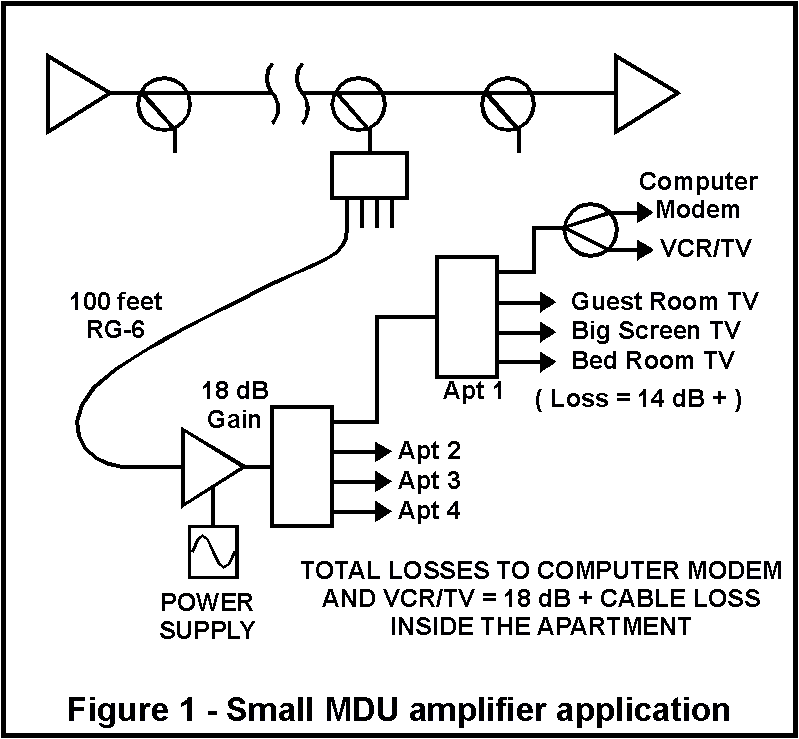( Published 1997 in Communications Technologies Magazine )

| USING
INTERMEDIATE GAIN HYBRID AMPLIFIERS IN CATV SYSTEMS ( Published 1997 in Communications Technologies Magazine ) |
|
| In the 1970's, a well-known CATV instructor lectured: "The best cable TV amplifier has 20 dB gain." In many applications in the headend or in some MDU installations, the decibel versus the dollar bill ratio (dB/DB) finds its mark in single-hybrid amplifiers with an 18 dB or 22 dB hybrid inside. This type of amplifier works in the home when a low-cost, 10 dB gain transistor amp has too much distortion due to high output levels. The single hybrid amplifier can also provide needed channel lash-up isolation in a single headend serving multiple franchise channel lineups. Headend applications will be discussed later in the article. | |
| Today's installer is sometimes faced with a need for more signal in the subscriber's home. Many homes have four or more outlets with the proliferation of VCR's, home theater system, bedroom tv, a tv set in the den, and now computer modems. Changing the tap in the feeder line will get more signal inside. But of course, that will increase the tap insertion loss and lower levels for the remainder of the feeder line. Solution: Amplify the drop signal. | |
| Amplifier manufacturers have responded with low-cost, low-gain drop amplifiers and house amplifiers with passive return, some with active return paths inside. These amplifiers work well when output levels in the +15 to +20 dBmV range are needed. For large hotel, motel and condo applications, there are many high gain, push-pull, power-doubled, feedforward and even DUAL POWER-DOUBLED (we say quadra-powered) amplifiers with two-way capability that work well for those applications. |  |
| For small multi-dwelling applications, low-cost transistor drop amplifiers with 10 dB gain are not enough. A good example is the patio home design prevalent in parts of South Florida. Four apartments with three bedrooms in each within a single ground level building are common. With these types of buildings, each residence could have four outlets and some of those outlets could have a two-way splitter to feed a converter, TV/VCR combination or computer modem. Just the splitter losses alone can account for up to 15 dB or more, not to mention drop cable loss and slope considerations at 550 or 750 MHz. | |
| With this kind of small MDU environment, a low-cost single hybrid amplifier with 17 to 21 dB of gain and an active or passive two-way return path has real possibilities (see figure 1). The push-pull hybrid configuration provides a higher output capability than low-cost single-ended transistor models. The output levels needed for these applications can easily be in the +25 to +40 dBmV range. The hybrid amplifier also has a better frequency response and some models have a plug-in pad and equalizer allowing a better chance of meeting peak-to-valley signal level requirements at the TV. Since the hybrid amplifier generates more heat than a transistor amplifier, a finned housing is quite often used. Make sure to mount the amplifier in an upright manner on a wall board or inside the tap enclosure box to allow convection cooling (figure 2). Remember hot air rises. Make sure the fins will allow convection air flow upward. Don't forget about moisture in the air. Is the amplifier location in a secure, stable environment? Above or near a furnace is not a good location. Is there soot or other contaminants in the air? Is there a swimming pool nearby? Chlorine from a swimming pool will evaporate and corrode metals in the area, a real problem here in Florida. | |
| TECHNICAL ARTICLES MENU | NEXT PAGE |